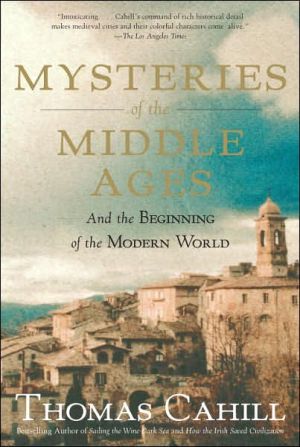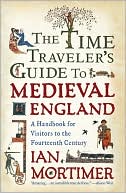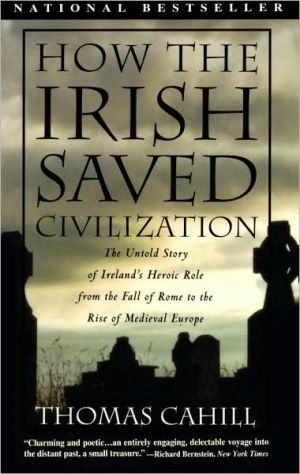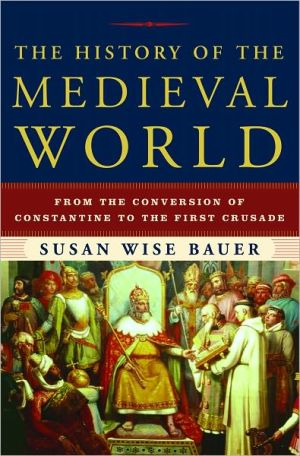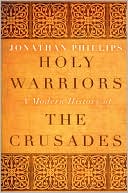Mysteries of the Middle Ages: And the Beginning of the Modern World
From the bestselling author of How the Irish Saved Civilization, a fascinating look at how medieval thinkers created the origins of modern intellectual movements.\ After the long period of decline known as the Dark Ages, medieval Europe experienced a rebirth of scholarship, art, literature, philosophy, and science and began to develop a vision of Western society that remains at the heart of Western civilization today, from the entry of women into professions that had long been closed to them...
Search in google:
From the bestselling author of How the Irish Saved Civilization, a fascinating look at how medieval thinkers created the origins of modern intellectual movements.After the long period of decline known as the Dark Ages, medieval Europe experienced a rebirth of scholarship, art, literature, philosophy, and science and began to develop a vision of Western society that remains at the heart of Western civilization today, from the entry of women into professions that had long been closed to them to the early investigations into alchemy that would form the basis of experimental science. On visits to the great cities of Europe-monumental Rome; the intellectually explosive Paris of Peter Abelard and Thomas Aquinas; the hotbed of scientific study that was Oxford; and the incomparable Florence of Dante and Giotto-acclaimed historian Thomas Cahill brilliantly captures the spirit of experimentation, the colorful pageantry, and the passionate pursuit of knowledge that built the foundations for the modern world. The New York Times - Ingrid D. Rowland The book is handsomely produced, with footnotes marked in medieval uncial letters and margins filled with fanciful designs like those in the margins of medieval manuscripts. The boxes with information on alumni of Alexandria and the system of Dante s Hell, among other topics, will help readers keep a wealth of facts in context; so will the generous complement of illustrations, most of them described by the author in enthusiastic detail, both in his captions and in the text itself. Cahill makes seemingly forbidding medieval works of art seem accessible, from the Byzantine formality of a 12th-century apse mosaic in Rome s church of Santa Maria in Trastevere (where he notes that the Virgin and Child are smiling at each other) to Giotto s 14th-century Arena Chapel in Padua (uncannily realistic to its first viewers). Even Dante s Inferno, as Cahill describes it, seems and is profoundly humane.
One\ Bingen and Chartres, Gardens Enclosed\ The Cult of the Virgin and Its Consequences\ In the first decade of the twelfth century, a little girl from the Rhineland town of Bermersheim, near Mainz, was offered by her parents as a sacrifice to God. Her name was Hildegard; her parents were Hildebert and Mechthild, a pious knight and his pious, well-born wife. Hildegard was eight years old when she was left for life with an anchorite named Jutta von Sponheim, who lived alone in a cell attached to the abbey church of Saint Disibod. (Disibod was a whimsical Irish monk-bishop of the seventh century who, disappointed at the lack of response to his preaching by his own countrymen, traveled to the Rhineland, became a protégé of the English Saint Boniface, evangelist to the Germans, and founded Disibodenberg, where he seems to have been rather more successful than he’d been in his native land.) Not only does Hildegard’s story embody many of the cultural currents that reached their ebb in her time or soon after; this outwardly obedient daughter, her childhood cut so cruelly short, was destined to become one of the most important women of her age.\ Using a living child as a religious oblation was no Christian invention. Greeks and Romans had ancient traditions of chaste priestesses and Vestal Virgins; and in the oldest records of both pagans and Jews we find evidence of “set-asides,” human offerings devoted to a divinity. In the earliest archeological records, these offerings are literal human sacrifices, such as the bog burials of Scandinavia. Jewish tradition yields such offerings in surprising numbers, starting with Abraham’s willingness to sacrifice his only son and continuing through Joshua’s command to his troops to “devote” the people of Canaan to God under “the curse of destruction”—that is,to execute them. In later times, prisoners of war were no longer slain outright, but firstborn males still had to be “consecrated to the Lord” and then “redeemed” by an animal sacrifice that was substituted for them, as happens to the newborn Jesus in the second chapter of Luke’s Gospel. There is even a further echo of Jewish tradition in the offering of Hildebert and Mechthild, for Hildegard was their tenth child—and a tenth of one’s wealth, the tithe of the Hebrews, was consecrated to God.\ But none of these grand historical precedents would have impressed an eight-year-old, who must have spent many a lonely, creepy night tucked away in Jutta’s sparsely appointed little hut. Anchorites are no longer an everyday occurrence—I have met only one in my life, and she was nutty as a fruitcake—but in the twelfth century they could be encountered in the neighborhood of many a monastery and even within the close of an urban cathedral. The word anchorite derives from a Greek verb meaning “to withdraw”; and we may best think of them as hermits who lived not in obscure caves but in association with a religious community. Your typical anchorite, though not necessarily a formal member of such a community, was nonetheless part and parcel of its sacred landscape, so much so that she (or he) would normally reside in a small room built into the wall of an abbey church or cathedral, a room with a view, so to speak—a slit or screened window that allowed the anchorite to attend church services but not so large as to make her visible to the merely curious.\ The liturgy for the consecration of an anchorite was actually a funeral liturgy, for it was deemed that she was dying to the world and to herself. She was spoken of as already dead and with God in heaven. Her cell was called frankly her “burial chamber,” and, dressed in her shroud, she was directed to sing a verse from Psalm 132: “This is my resting place forever, here shall I dwell for I have chosen it.” The ceremony, attended gregariously by family, friends, and monastic benefactors, must strike us as a ghoulish sort of celebration, often ending with the ritual interment of the anchorite in her cell, from which it was expected that she would never again emerge. Brick was cemented on brick till the doorway to the cell was blocked and only the slit was left, enough for food and other necessities to be passed to her. If the ceremony did not conclude with an immuring, it concluded with a permanently locked door. But because this period is characterized by such variation in custom from one locality to another, we cannot be certain what was done in Hildegard’s case, nor whether the growing girl was permanently locked away in thecustomary single room. We do possess one odd detail that may bespeak a certain mitigation: at least one servant was locked in along with the anchorites. Jutta and Hildegard were, after all, noblewomen and so could not be expected to manage even their much-reduced needs by themselves.\ The idea was to serve God by permanent prayerful retreat from the world. However bizarre this may sound to modern ears, we probably all know a few people whose apartness (or even madness) might be better served if such a socially approved role were still available. Though often represented as a period of repression, heavy with superstition, the Middle Ages offered—at least in religious roles—more options than are now allowed. I doubt that a frail suppliant, plainly dressed and with a distracted air, approaching a bishop today to say that God had instructed her to build a cell into the wall of his cathedral and to carve in that wall a small window from which she could hear mass, as well as the canonical hours, would receive a warm response. But in the Middle Ages such social oddities were welcomed and assigned a place of honor. While the rest of us went about our worried lives, they prayed for us continually, speaking always to God on our behalf.\ The masters of the Middle Ages had, of course, another, less public motive for honoring anchorites. The batlike monks of the Prologue who terrorized the citizens of Alexandria might have been politically useful to the patriarch, but as time went on such mobs, vociferous, usually illiterate, became a religious plague. They could not be appeased by compromise; they were rabble-rousing extremists, unswervingly certain of their rectitude. Their implacable attitudes gave bishops, as well as other public men in charge of social order, terrible headaches. How were they to be quieted? By being brought under the bishop’s control, by being made subject to his rules and approval.\ Every monkish mob was incited by a leader, often a desert hermit cherished for his holy ability to live apart from society, eating locusts, whipping his body, gifted with extravagant visions. The word monk derives, in fact, from the Greek word monos, meaning “alone, lonely, solitary.” In the rudimentary beginnings of monastic life, all monks were hermits, and only gradually did they unite in loose association with one another. Bishops began to invite the most influential solitaries to take up more conventional habitats, closer to human society and more readily subject to episcopal pressure. Monks and nuns, monachi and monachae, were made to write constitutions by which their communities were to be governed. In time, such constitutions came to be submitted to a bishop for his approval.\ In the West, Saint Benedict, Italian founder of the Benedictines, became in the early sixth century the great constitutionalist, his Rule the standard by which all subsequent monasticism was judged. The monk’s life was utterly subject to his dictum Ora et labora (Pray and work). No rabble-rousing, please. Let anarchy be not so much as mentioned among us. In time, obedience, tranquility, and constructive employment—building, farming, herbal medicine, relief for the poor, succor for the sick, hospitality to wayfarers, manuscript copying, and (in the case of a gifted few) original writing—not vision, came to rule the Christian West. The Benedictines, in addition to vows of obedience, chastity, and community of goods, took a vow of stability, which meant they could not leave the monastery grounds without their abbot’s permission. Even prayer was measured out at appointed hours. No moment of the monk’s day or night belonged exclusively to him. The bishops, who—thanks to the barbarians—had quite enough on their plates, required such a church, where everyone, even a visionary hermit, could be counted on to play an assigned role and to stay within prescribed limits.\ No one had done so much to spread the fame of Saint Benedict as Gregory the Great, who was himself a Benedictine monk and had written Benedict’s Life. By Hildegard’s day, even an abbey like Disibodenberg, originally a foundation of Celtic spontaneity, had submitted to the Rule of Saint Benedict. In the abbey church, the monks sang the canonical hoursa—as did all Benedictines from Britain to Bohemia—and from a lancet opening in the choir wall a single female voice united with theirs in chant. One day, a pure child’s voice joined in, inflecting the Latin words precisely, ascending gloriously and certainly to the subtle rhythm of the music. In their choir stalls the monks shivered with emotion: it was the voice of the child anchorite, the noble Hildegard.\ We know little of what went on in Jutta’s cell, but we know the results. Under the older woman’s tutelage, the child learned to read the Book of Psalms in Latin and to sing the psalms of the monastic hours, the church’s Divine Office, while accompanying herself on the expressive ten-string psaltery, a sort of dulcimer plucked by hand.Throughout her life Hildegard’s Latin remained odd, at moments an almost private language. But her grasp of the principles of musicology was remarkable, eventually impelling her to compose her own chants, unusual in sound and singular in subject matter.\ Beyond the Book of Psalms, Hildegard’s adult writings—a substantial survival—show evidence of reading so wide as to rival and even surpass that of the most accomplished scholars of her time. She makes reference to the other books of the Bible, especially the Prophets,to the usual biblical commentaries, to liturgical texts, to the Benedictine Rule, and to the Western fathers—Jerome, Augustine, Gregory, and Bede. Her Plotinian Platonism probably came to her by way of the ninth-century Irish philosopher John Scotus Eriugena, whose sermons and ruminations were standard texts, and she seems to have read reforming contemporaries, such as Hugh of Saint Victor and Bernard of Clairvaux, as well as earlier Christian classics, such as the Shepherd of Hermas and Adso’s On the Antichrist. Some have speculated that there are hints in her writings of such Carolingianb authors as Isidore of Seville, Rabanus Maurus, Paschasius Radbertus, and Notker of Saint Gall; and there are strong suggestions that she had access to Greek (and perhaps to Arabic) medical works and even to arcane rabbinical treatises. This, for an age in which books were scarce and precious, is an astounding catalogue, a library available to few men and to (so far as we can tell) no other woman. The library must have belonged not to Jutta, who could hardly have accommodated it in her hut, but to the liberally lending monks of Disibodenberg. What went on in Jutta’s cell was a lifetime reading program.\ But what of the eight-year-old who was made to live in such unnatural confinement and who survived the rigorous reading program—and even flourished because of it? Does anything of her—anything personal, peculiar, intimate—remain in the historical record? To answer these questions we must step back a bit and consider more widely the currents of twelfth-century life, not nearly as open as ours to personal preference and psychological insight.\ Life spans had not increased since the classical centuries; indeed, they had dipped dramatically during the terrifying uncertainties of the barbarian influx and were only now—in the new economic and cultural stability of twelfth-century Europe—beginning to approach the best Greco-Roman levels. An eight-year-old, even a child of privilege such as Hildegard, was not as young in the eyes of her parents as she would be in ours. At the same age, her lesser-born male contemporaries were preparing for apprenticeships in the homes of strangers—millers, bakers, chandlers, glaziers, fullers, coopers, wainwrights, and such—and many of her female contemporaries, already betrothed, were beginning to contemplate their coming roles as matrons of households. Hildegard was thought quite old enough to make a lifetime commitment.\ But should we assume that Hildebert and Mechthild forced their daughter into an anchorite’s life? In Scivias, the book by which she is best known, Hildegard would counsel parents on the utter necessity of obtaining their child’s consent before offering him as an oblation. “If you offer a child to Me,” says the voice of Jesus, and that offering is against his will because you have not sought his consent to it, you have not acted rightly; you have offered a ram. How? If someone offers a ram at My altar without binding its horns strongly with ropes, the ram will certainly run away. So also if a father or mother offer their child, who is the ram, to My service, but do not honor his will, which is his horns, by assiduous care or supplication or entreaty or diligent exhortation, which are the ropes that bind him, since by all these the child should be brought to consent in good will; not having been proved by these tests, he will certainly run away, physically or mentally, unless God guards him by miracle.\ And if you, O human, confine that child with such great strictness of bodily discipline that he cannot free himself from the pressure of his will’s repugnance, he will come before Me [at the Last Judgment] arid and fruitless in body and soul because of the captivity unjustly inflicted on him without his consent. Then I will say to you, O human who has bound him:\ I had a green field in My power. Did I give it to you, O human, that you might make it put forth whatever fruit you wished? And if you sow sand in it, can you make it grow into fruit? No. For you do not give the dew, or send forth the rain, or confer fresh moisture, or draw warmth out of the burning sun, all of which are necessary to produce good fruit. So too, you can sow a word in human ears, but into his heart, which is My field, you cannot pour the dew of compunction, or the rain of tears, or the moisture of devotion, or the warmth of the Holy Spirit, through all of which the fruit of holiness must grow.\ And how did you dare so rashly to touch one dedicated and sanctified to Me in baptism, that without his will you handed him over to bear My yoke in strict captivity; so that he became neither dry nor green, not dying to the world or living in the world? Why have you so oppressed him that he can do neither? If I comfort him by miracle so that he may remain in the spiritual life, that is not for humans to look into; for I want his parents not to sin in his oblation, offering him to Me without his will.\ From the Hardcover edition.
List of Illustrations xiiiA Chaucerian Invitation 1Prelude: Alexandria, City of Reason: The Great Confluence 5Introduction: Rome, Crossroads of the World: How the Romans Became the Italians 31Bingen and Chartres, Gardens Enclosed: The Cult of the Virgin and Its Consequences 65Aquitaine and Assisi, Courts of Love: The Pursuit of Love and Its Consequences 117Intermezzo: Entrances to Other Worlds: The Mediterranean, the Orient, and the Atlantic 176Paris, University of Heavenly Things: The Exaltation of Reason and Its Consequences 187Oxford, University of Earthly Things: The Alchemist's Quest and Its Consequences 214Padua, Chapel of Flesh: The Artist's Experiment and Its Consequences 230Florence, Dome of Light: The Poet's Dream and Its Consequences 269Ravenna, City of Death: The Politician's Emptiness and Its Consequences 301Postlude: Love in the Ruins: A Dantesque Reflection 313Notes and Sources 319Acknowledgments 327Permissions Acknowledgments 328Photography Credits 329Index 331
\ From Barnes & NobleTom Cahill's Hinges of History epoch takes a major pivot in this seventh installment. By his reckoning, the Middle Ages moved Europe toward a vision of society that we can still recognize today. Hotly contested ideas about theology, philosophy, scholarship, art, and literature challenged and redefined thinking in every layer of society. As in previous volumes, Cahill presents these issues with vivid examples and a passionate sense of their contemporary relevance. This gorgeously illustrated volume features stunning four-color reproductions of medieval artistic masterpieces.\ \ \ \ \ Ingrid D. RowlandThe book is handsomely produced, with footnotes marked in medieval uncial letters and margins filled with fanciful designs like those in the margins of medieval manuscripts. The boxes with information on “alumni of Alexandria” and “the system of Dante’s Hell,” among other topics, will help readers keep a wealth of facts in context; so will the generous complement of illustrations, most of them described by the author in enthusiastic detail, both in his captions and in the text itself. Cahill makes seemingly forbidding medieval works of art seem accessible, from the Byzantine formality of a 12th-century apse mosaic in Rome’s church of Santa Maria in Trastevere (where he notes that the Virgin and Child are smiling at each other) to Giotto’s 14th-century Arena Chapel in Padua (uncannily realistic to its first viewers). Even Dante’s “Inferno,” as Cahill describes it, seems — and is — profoundly humane.\ — The New York Times\ \ \ Publishers WeeklyCahill's latest engaging romp through pop intellectual history (after Sailing the Wine-Dark Sea) focuses, despite the subtitle, not on fringe cults, but on the mainstream of medieval Roman Catholic thought. Instead of obscurantist dogma, he finds a ferment of implicitly progressive ideas that laid the groundwork for modernity. The veneration of the Virgin Mary, he contends, prompted a boost in women's status, exemplified by the mystic nun Hildegard of Bingen, who gained public status and power as a spiritual figure. The papacy's claim of spiritual authority independent from temporal power contained the seeds of modern notions about the separation of church and state, democracy and the legitimacy of political dissent. And the perennial head scratching over the doctrine of transubstantiation, he argues, stimulated the beginnings of both empirical science and artistic realism. Cahill's treatment is more impressionistic than systematic, and built around lively profiles of iconic medievals like Abelard and H lo se, Francis of Assisi and Giotto, whose paintings get a long, lavishly illustrated exegesis. The author wears his erudition lightly and leavens his writing with reader-friendly anachronisms, likening Hildegard to blues chanteuse Bessie Smith and calling the Franciscans "the world's first hippies." The result is a fresh, provocative look at an epoch that's both strange and tantalizingly familiar. Photos. Color illus. throughout. (Oct. 24) Copyright 2006 Reed Business Information.\ \ \ \ \ Library JournalCahill (How the Irish Saved Civilization) continues his history of Western civilization with this volume, in which he attempts to show how the Catholic Middle Ages laid the groundwork for many of the attractive features of today's world, such as the elevation of women's status and our reorientation toward the natural world. He focuses on a few great figures but even so has little insightful to add. Though an engaging writer, Cahill is an appallingly bad historian. He compares the medieval nun Hildegard of Bingen to blues singer Bessie Smith (arguing that Hildegard's lyrics display a spiritualized eroticism) and to the woman in bondage in The Story of O, referring also to Desperate Housewives and Sex and the City ("This was one loose sister"). He compares Dante to James Joyce because both were exiles infatuated with their mother cities. He characterizes World War I's Battle of Gallipoli as a "confrontation between Islam and the West." Throughout, he tramples history into a muddled paste of great figures and exalting moments, ignoring nuance or exception. He concludes with a five-page diatribe against sycophancy and buggery in today's Church. The footnotes don't inform much; the bibliography omits essential scholarship (e.g., R.W. Sothern on medieval humanism, Roberto Lopez and Lauro Martines on Renaissance humanism). It is difficult to conceive of an audience that would benefit from reading this silly and superficial book. [See Prepub Alert, LJ 6/1/06.] David Keymer, Modesto, CA Copyright 2006 Reed Business Information.\ \ \ \ \ Kirkus ReviewsA prodigiously gifted popularizer of Western philosophical and religious thought spotlights exemplary Christians in the High Middle Ages. In this fourth of a projected seven-volume series, "Hinges of History," Cahill (Sailing the Wine-Dark Sea, 2003, etc.) takes issue with the stereotypical depiction of the 12th to early-14th centuries as the superstitious Dark Ages. To be sure, he criticizes the period's kings and most popes for spreading authoritarianism and corruption. But he reminds us that the period also saw Greek natural philosophy intertwine with Christian "incarnationalism," which, by seeking God's truth in human form, revived natural science and produced greater artistic realism in depicting the body. Especially important to these trends were "enveloping, energizing" misfits such as Peter Abelard, Thomas Aquinas, Francis of Assisi, the painter Giotto, the friar-scientist Roger Bacon and the mystic/nun Hildegard. Like another one of these heroes, Dante, Cahill consigns certain of his own contemporaries into a rhetorical hell, notably George W. Bush, for waging "imperial war" in Iraq, and Pope Benedict XVI, for inattention to priest sexual abuse scandals while serving as John Paul II's chief doctrinal advisor. At worst, his underscoring of contemporary relevance lapses into breeziness (e.g., Eleanor of Aquitaine was a "smart cookie") and the intellectual parlor game of "What Would So-and-So Do?" (Dante would have been a UN supporter). But Cahill describes Italy's landscape and people with the same kind of brio that enriched the treatment of his own ancestral country in How the Irish Saved Civilization (1995). Writing of Padua, for example, he notes, "the city boasts some of thelargest and best proportioned piazzas in Italy, as well as a twisting fantasy of domes and towers." The author also excels at underscoring the era's defining icons, such as images of Madonna and Child that revealed "the innovative Christian sense of grace, no longer reserved for the fortunate few."Not an original scholar, Cahill serves as an irresistible guide: never dull, sometimes provocative, often luminous.\ \
